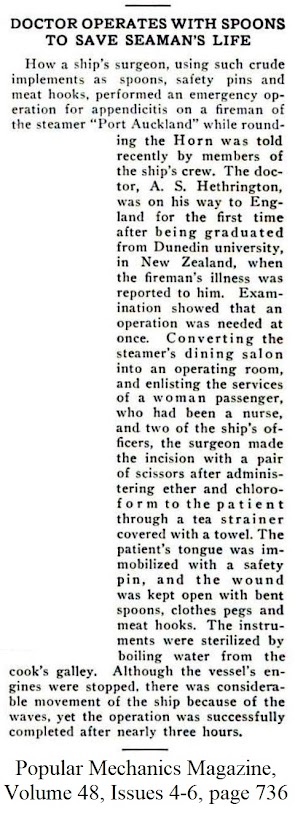No
one ever thinks about the lowly safety pin!
It’s a wonderful tool that is all too often taken for granted and,
unfortunately, also often forgotten! Safety
pins have been around forever,1 but they were accidently reinvented in
modern times by a U.S. inventor, named Walter Hunt, in 1849. He was desperate to pay a debt and was nervously
twisting a piece of wire when he looked down and saw the design for a safety
pin. He paid off his debt, by selling
the rights to the safety pin for just $400.00!2
“So,
what does the safety pin have to do with survival”, you ask? Well, let’s talk about it.
One
of the best lists, that I have found for improvised wilderness uses of safety
pins, was created by Dr. Eric A. Weiss, a wilderness medical expert and
professor of Emergency Medicine at Stanford University, for the Second Congress
on Wilderness Medicine.
Let’s
talk about some of these and some others that didn’t make Dr. Weiss’s list.
First
of all, ouch! But safety pins can be
very useful in emergency surgery and keeping the airway open is vitally
important.
Holding gaping wounds together...
Years
ago, when my youngest son was 13 and was going to Boy Scout Camp, I helped him
to pack a survival kit so he could take the survival merit badge. I packed three large safety pins into it and
told him about all the different uses for them and how in an emergency you
could use them to hold gaping wounds together.
The instructor was a product of nepotism,
daddy was a big wig in the local council, and he roundly criticized my son
saying that you couldn’t do that. But
you can and here is how you do it.
This was a common way of closing gaping wounds until quite recenttimes, and in fact the Masai, and other tribes, in East Africa, routinely used thorns, flame treated to harden and sterilize them, with string to close wounds, much the way we still close turkeys before roasting them.
Relieving a subungual hematoma...
Subungual hematomas result from injuries to the nail bed that cause bleeding under the finger or toenail. The blood pools under the nail, and turns a reddish, brownish, blueish, or grey/blackish color. The pooled blood puts pressure on the nailbed causing throbbing pain which often disappears when the pressure on the nail bed is relieved by drilling and draining. Subungual hematomas can be treated within 48 hours of injury, by making a hole through the nail into the hematoma with a safety pin that has been sterilized in a flame. This is a process called trephining and drains the blood and releases the pressure.
Fishhooks...
Fixing things...
The
things that can be fixed with safety pins are limited only by your
imagination! You can fix fishing poles,
glasses, broken sipper pulls, ski bindings, ripped buttonholes or clothes, or
even unclogging camping stove jets.
Organizing and attaching things...
Other uses are limited only by your
imagination...
But where or wear should you keep
them...
You should always have some with you, kept in your repair or “possible” kit (for more on “possible” kits read So, What’s in Your Possible Kit!? ©, HERE), pinned to the inside of a chest pocket flap, or pinned elsewhere on your shirt, and definitely in your survival kit.
Don’t forget to come back next week and read “100-MPH Tape ©”, where
we will talk about how to camp in the winter wilderness and stay warm and safe.
I
hope that you continue to enjoy The Woodsman’s Journal Online and look for me
on YouTube at BandanaMan Productions for other related videos, HERE. Don’t forget to follow me on both The
Woodsman’s Journal Online, HERE,
and subscribe to BandanaMan Productions on YouTube. If you have questions, as always, feel free
to leave a comment on either site. I
announce new articles on Facebook at Eric Reynolds, on Instagram at
bandanamanaproductions, and on VK at Eric Reynolds, so watch for me.
That
is all for now, and as always, until next time, Happy Trails!
Notes
1
Ancient
examples of safety pin, or fibula as they are called, from the 11th
to 10th century BCE, have been found in Crete, per Oscar W.
Muscarella, “Ancient Safety Pins”
2
“Medical
Miracles”, by Richard Bauman, reported that the design was sold for $400.00,
other sources state $300.00.
Sources
Bauman,
Richard; “Medical Miracles”, The
Rotarian, Jun 1989, page 16 to 19
https://books.google.com/books?id=ZzIEAAAAMBAJ&pg=PA18&dq=safety+pin&hl=en&sa=X&ved=2ahUKEwiB3cvxy-GAAxWFnokEHYBgDwQ4KBDoAXoECAcQAg#v=onepage&q=safety%20pin&f=false, accessed August 23, 2023
Erichsen, John Eric; The Science and Art of Surgery,
Volume 2, Tenth Edition, [London, Longmans, Green & Co., 1895], page 665-666,
https://books.google.com/books?id=HACCp4Q5z-AC&pg=PA666&dq=trussing+pins+suture&hl=en&newbks=1&newbks_redir=0&sa=X&ved=2ahUKEwj47cG4utqAAxVOGlkFHa6SDpsQ6AF6BAgFEAI#v=onepage&q=trussing%20pins%20suture&f=false,
accessed August 13, 2023
Friedmann, Lawrence W.; “Amputations and Protheses in
Primitive Cultures”, Bulletin of Prosthetics Research, Spring 1972, page
131, https://books.google.com/books?id=ArWmmxfpYB8C&pg=RA1-PA131&dq=thorn+sutures+africa&hl=en&newbks=1&newbks_redir=0&sa=X&ved=2ahUKEwjBt53-t9qAAxVZD1kFHWEdAxUQ6AF6BAgMEAI#v=onepage&q=thorn%20sutures%20africa&f=false,
accessed August 13, 2023
Muscarella, Oscar W.; “Ancient
Safety Pins”, Expedition Magazine 6, no. 2 (January, 1964), https://www.penn.museum/sites/expedition/ancient-safety-pins/,
accessed August 18, 2023
Wikimedia, “Annual_report_of_the_Board_of_Regents_of_the_Smithsonian_Institution_(1929)_(14596908300)”,
https://commons.wikimedia.org/wiki/File:Annual_report_of_the_Board_of_Regents_of_the_Smithsonian_Institution_(1929)_(14596908300).jpg, accessed August 18, 2023
Wikimedia, “Patent_6281.jpg”,
by William L. Hunt, 1849, https://commons.wikimedia.org/wiki/File:Patent_6281.jpg,
accessed August 18, 2023
Wikimedia; This is a subungual
hematoma of the finger”, November 2, 2014, by Callaleo, https://commons.wikimedia.org/wiki/File:Subungal_hematoma_of_the_finger.jpg,
access August 19, 2023


















No comments:
Post a Comment